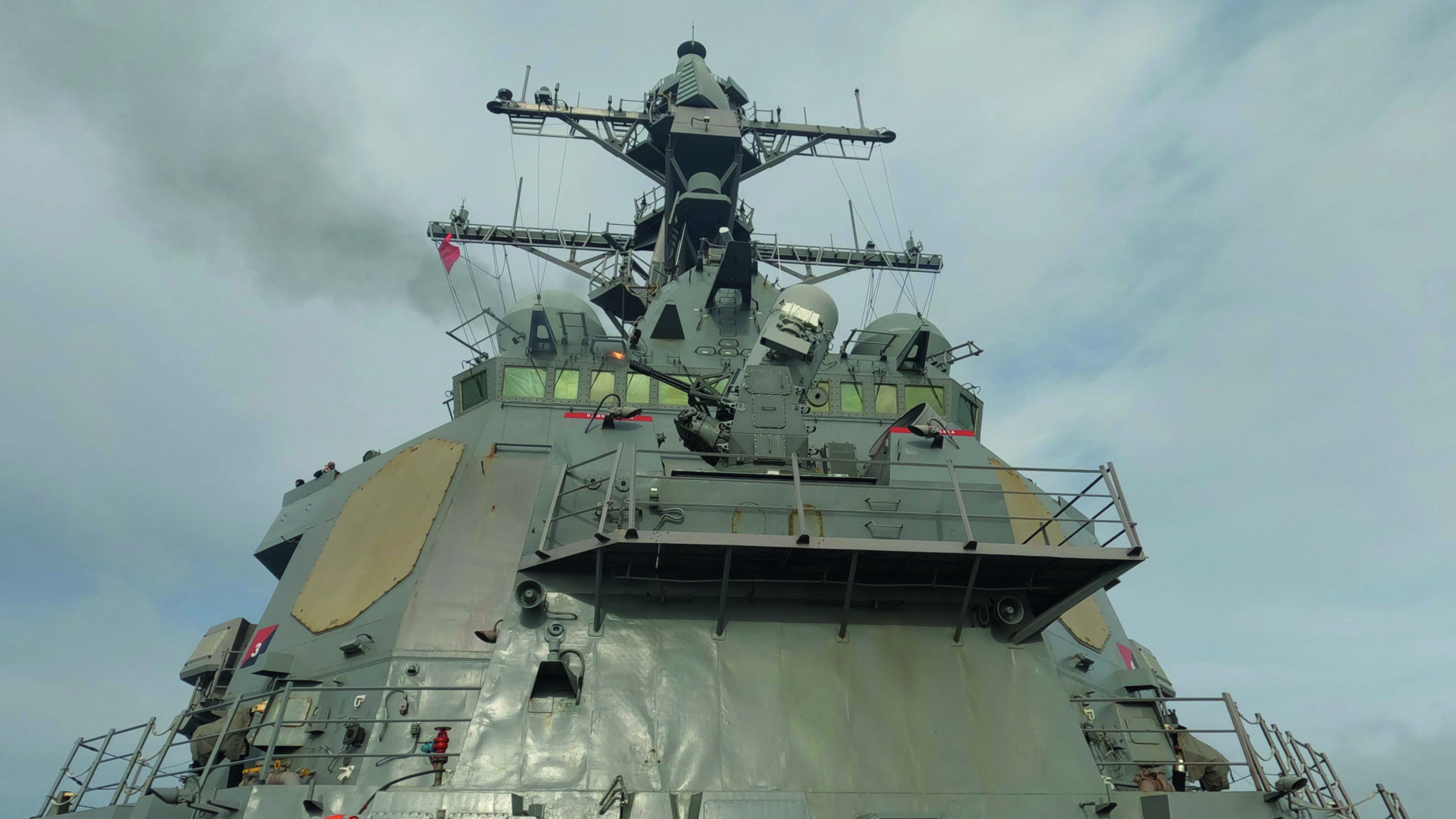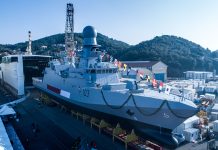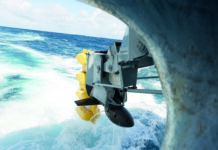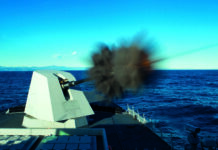The proliferation of short and intermediate ballistic missile inventories, together with anti-ship ballistic missile threats in recent decades, has resulted in the development of Integrated Air and Missile Defence (IAMD) capabilities for both naval and land applications.
Background to Naval Ballistic Missile Defence
The navies of NATO and European Union (EU) members are today increasingly contributing to the Alliance and ‘Old Continent’ Ballistic Missile Defence (BMD) operations. The US contribution to NATO’s missile defence is conducted through the European Phased Adaptive Approach (EPAA). This happens together with the Maritime Theater Missile Defence Forum, which includes:
- Australia
- Canada
- Denmark
- France
- Germany
- Italy
- Norway
- the Netherlands
- Spain
- the UK
- the US
Moreover, the dedicated IAMD At-Sea Demonstration/Formidable Shield exercises, alongside the EU Defence technological and operational developments, are supporting NATO and EU efforts to develop integrated and layered BMD networks to which every nation is contributing as part of a unified architecture with transnational and national industries.
US Platforms and Effectors
The US AEGIS BMD capabilities capitalises on and evolves from the existing US Navy’s Lockheed Martin AEGIS Weapon System (AWS) and Raytheon Standard Missile (SM) infrastructures. The AEGIS BMD provides a forward-deployable capability to detect and track missiles of all ranges. It also has the ability to destroy Short-Range Ballistic Missiles (SRBM) and Medium-Range Ballistic Missiles (MRBM) in both the mid-course and terminal phases of flight, alongside the Intermediate-Range Ballistic Missiles (IRBMs) in the mid-course phase of flight, according to US Missiles Defense Agency (MDA).
By the end of FY 2022, there will be 48 BMD capable ship available, including TICONDEROGA class CG-47 cruiser and ARLEIGH BURKE class DDG-51 guided destroyers. Lockheed Martin is the lead contractor for the DDG-51 AEGIS combat system and provider of S-band SPY-1B/D radar and AEGIS combat system, while Raytheon is the lead contractor for the combat system of the three DDG-1000 ZUMWALT class destroyers and its core provider together with the SPY-3 radar. Exploiting the improved radar range, discrimination and engagement capabilities offered by the new Raytheon S-band AN/SPY-6 Advanced Air and Missile Defence Radar (AMDR), as well as the enhancements to in-service Lockheed Martin S-band SPY-1B/D families with the installation of antenna low noise amplifiers, AEGIS will increase capability against longer range and more capable sophisticated threats.
It does so across the main weapon system spirals/production lines and associated baselines (BL): BMD 5.1 (BL 9.C2), BMD 4.2 (BL 5.4.1) and BMD 6.0 (BL 10). The AEGIS BMD uses the Raytheon SM-3 family of guided missiles against exo-atmospheric ballistic missile threats alongside Raytheon SM-6 guided missiles that are used by the AEGIS Sea-Based Terminal (SBT) (Increment 1 and 2) for endo-atmospheric engagements.
New Weapon
Having achieved Initial Operational Capability (IOC) in 2014, the SM-3 Block IB contributes to expanding the BMD battlespace. It also engages longer range and ballistic missiles that are more sophisticated that may deploy countermeasures and launch in larger raid sizes. It is also equipped with a more flexible Throttleable Divert and Attitude Control System divert engine (vs Block IA). The SM-3 Block IB features a Kinetic Warhead’s (KW) two colour infrared (IR) seeker and advanced signal processor and provides a real-time discrimination and characterisation capability while improving sensitivity for longer range targets and performance against more sophisticated threats. Developed co-operatively by the US and Japan, the SM-3 Block IIA provides greater capability over SM-3 Block IB. This includes increased velocity and range provided by a 53.34 cm (21-inch) diameter rocket motor propulsion stack, more than doubled seeker sensitivity, and more than tripled divert capability incorporated in an advanced KW.
As the primary extended range air defence weapon for AEGIS cruisers and destroyers and potential future combatants, the SM-6 combines the airframe and propulsion system from the SM-2ER Block IV interceptor with the active radar seeker of the AIM-120C AMRAAM missile, while retaining the legacy SM semi-active radar homing capability for the terminal guidance phase. In service in both the Block I and Block IA, the latter provides improved performance against advanced threats. The SM-6 Dual I variant is fielded and provides sea-based terminal BMD capability against short-range ballistic, as well as cruise missiles. The under development and more capable Dual II missile is designed for use in the terminal phase of a short- to-medium range ballistic missile trajectory.
ASTER Family and Block 1 NT Version
Under a French-Italian cooperation programme launched in 2016 and managed today by OCCAR procurement agency, the two MoDs are working to put into service the ASTER 30 Block 1NT (New Technology). This is the latest member of the MBDA ASTER missile family, capable of dealing with both ABT and the latest missile threats, including supersonic and ballistic systems for both land and naval applications. Last February, the UK MoD announced the plan to provide a BMD capability to the Royal Navy and ‘the wider Defence’. This will initially upgrade its inventory of ASTER 30 missiles, and the procurement of the ASTER 30 B1 NT later on. Developed under the French-Italian Future Surface-to-Air Family (FSAF) programme, the MBDA ASTER missile family was conceived as a dual stage vertically-launched missile concept featuring a common terminal stage. This is also known as ‘dart’, with an active Ku-band seeker and a booster stage which comes in two different versions, thereby ensuring a range in excess of 30 km for the ASTER 15 and 120 km for the ASTER 30. Both systems are currently used by Surface Anti-Air Missile (SAAM) and PAAMS naval air defence systems by the Eurosam consortium. This includes:
- Thales and MBDA (France and Italia) and MBDA UK (PAAMS S)
- the SAAM ESD (SAAM Extended Self Defence) family by MBDA Italia
- MBDA France for the French Frégate de Défense et d’Intervention (FDI) in addition to international customers
The ASTER 30 also equips the land-based Eurosam SAMP/T system in the Block 1 version, which incorporates a proximity fuse and a blast fragmentation warhead effective against both ABT and Tactical Ballistic Missiles (TBMs) threats. According to MBDA, and as demonstrated in operational firings by SAMP/T system, the current ASTER 30 Block 1 is capable of dealing with TBMs in the SCUD class with a 600 km range.
Way Ahead
The new ASTER 30 B1 NT is being developed in the latest iteration under a contract assigned in March 2021 by OCCAR to the Eurosam consortium. This version features a new enhanced weapon controller and a new active RF seeker operating in the Ka band, while the munition retains the same size, mass, and booster, allowing it to be used by all current launchers for both land and naval applications. Developed by the Thales seeker division with the support and components from the MBDA seeker division in Italy, the B1 NT seeker, together with the new weapon controller by MBDA, brings an increased target acquisition range. It also has the capacity to acquire targets with a lower radar cross section and thinner angular resolution for increased target localisation accuracy, thus significantly improving direct impact probability. According to released information, the B1 NT will be able to cover the entire SRBM threat domain, as well as the Medium Range domain up to 1,500 km range. The new version will also be capable of coping with TBMs with multiple warheads, as well as those with terminal guidance used in Anti-Ship Ballistic Missiles (ASBM).
The latest Enhanced Capability under-development iteration, which is to provide longer range and higher altitude engagements to cope with new missile threats, is part of the ASTER 30 B1 NT baseline capabilities. The ASTER 30 B1 NT has an interception range of over 150 km against ABTs and can reach over 20,000 m altitude as part of the SAMP/T NG system. Based on latest French defence budget documentation, first series-production deliveries are planned for 2027.
BARAK MX Naval
In April 2021, the Israel Aerospace Industries (IAI) group announced the successful completion of a series of trials, including the interception of a ballistic missile surrogate threat that concluded the qualification phase of the BARAK Extended Range (ER) missile, the latest iteration of the BARAK interceptor family, and the launch of its delivery process to an undisclosed customer. With the availability of the BARAK ER for both land and naval applications, the combat proven BARAK MX family of Air & Missile Defence missile systems expands the capability to intercept ABTs at the extended range of 150 km alongside ballistic and other missile threats.
The BARAK MX family of Air & Missile Defence missile systems already includes two interceptors sharing the same 22.7 cm airframe diameter. These are the Medium Range Air Defence (MRAD) with a single solid fuel pulse rocket motor and the LRAD with a dual/solid fuel pulse rocket motor with a 35 km and 70 km maximum range, plus a 10 km and 20 km maximum intercept altitude. The addition of the BARAK ER, with its 150 km range and 25 km altitude of intercept, provides enhanced flexibility to the overall system, the booster, plus the dual-impulse rocket motor allowing the missile to reach a significantly higher speed and manoeuvrability in the vicinity of the target thanks to the second impulse. The new interceptor is the result of the combination of a standard BARAK LRAD missile with a solid rocket propellant booster. This adds 1.3 m to the 4.5 m of the LRAD munition and increases the diameter to 0.35 m, while the weight at launch is 400 kg (versus 280 kg of the LRAD). The warhead is also different, as it is of a blast fragmentation type, which provides higher lethality while the active RF seeker introduced new algorithms for dealing with ballistic missile threats and the munition is expected to maintain the LRAD two-way data link concept. As the booster diameter falls within the current BARAK missile canister size, the difference lies in its length due to the longer 5.8 m munition plus booster.
TWISTER
In November 2019, the EU Council implemented the Timely Warning and Interception with Space-based TheatER surveillance (TWISTER) capability project within the Permanent Structured Cooperation (PESCO) framework. Coordinated by France and including Finland, Germany, Italy, the Netherlands and Spain, the project seeks to develop a multi-role endo-atmospheric interceptor and a space-based early warning to address emerging threats and is expected to be brought into service in 2030, with support from the European Defence Fund (EDF).
Last December, an industrial consortium led by MBDA group responded to the EU call for a concept exploration study regarding an endo-atmospheric interceptor capable. The main requirements are to be able to operate with both naval and ground systems and allow engagements in a multi-system and multi-platform architecture. The design should primarily be optimised to deal with:
- ballistic missiles up to 3,500 km
- ASBMs up to 2,500 km
- hypersonic glide vehicles released by TBM similar carriers with up to 3,500 km range
- high altitude hypersonic and supersonic cruise missiles
- secondary targets such as subsonic and supersonic cruise missiles and ABT threats
The follow-on developments of these studies could led to the successor of European SAMP/T and PAAMS systems in the long-term.
Early Warning and Long-range Surveillance Radars
The naval BMD early warning sensors have attracted greater interest in recent years although there are still scarce resources within the current national and alliance territorial and expeditionary defence concepts. In addition to US solutions already discussed, the European and Israeli industries are offering new products.
Thales SMART-L MM/N
During the US-led NATO At-Sea Demonstration/Formidable Shield 21 (ASD/FS 21)exercise in May 2021, the Royal Netherlands Navy (RNLN) DE ZEVEN PROVINCIËN air defence and command frigate, equipped with the Thales’ long range surveillance D-band SMART-L MM/N radar, was able to autonomously detect a ballistic missile surrogate and provide tracking data through the NATO Communication network to the US Navy PAUL IGNATIUS guided-missile destroyer. These data enabled the latter platform’s combat system to launch an SM-3 Block IA exo-atmospheric interceptor against a ballistic missile target outside the range envelope of its own radar – known as ‘Launch on Remote’ (LoR). It was able to guide it to intercept the non-separating ballistic missile surrogate well outside the earth’s atmosphere.
During the same exercise in another live event, thanks to Thales radar suite information, the RNLN frigate was able to conduct engagements on air threats, while simultaneously tracking a ballistic missile threat. In addition to the new radar, the frigate received modifications to the Combat Management System (CMS) and the new LINPRO link processor.
Developed by Thales Nederland, the MM/N version is the latest and fully digital iteration of the SMART-L long-range D-band radar, which introduces a series of hardware, software and operating mode improvements, including a new high-power active AESA antenna based on GaN Transmitter Receiver Modules (TRM). Together with the dual-axis multibeam receiver technology, these enhancements enable the radar to detect a very wide variety of objects including stealth, short and up to long range ballistic missiles and also space objects up to a 2,000 km instrumented range (480 km instrumented range versus air targets) with a 1,000 objects tracking capacity. Installed on all four DE ZEVEN PROVINCIËN frigates, the SMART-L MM/N is being considered by current and other potential customers.
Leonardo KRONOS POWER SHIELD
Basec on the RAT-31/FADR L-band long-range radar developments, the ATBMD NATO activities participation and new technologies insertion, Leonardo developed the fully digital D-band KRONOS POWER SHIELD early warning radar for tactical ballistic missile surveillance and defence. Conceived for both naval and land applications, the KRONOS POWER SHIELD is Leonardo’s first fully digital radar using state-of-the-art digital beam forming (DBF) technology and latest high power GaN technology.
The new AESA software defined radar features a digital antenna architecture based on 1000+ radiating elements grouped in DATs (Digital Active Tiles). This system implements a full radar chain for each single radiating element, providing excellent tracking accuracy thanks to bi-dimensional digital mono-pulse capability, high range resolution (wide band) to discriminate TBM boosters from TBM re-entry vehicles, advanced ECCM capabilities and clutter/multipath suppression by means of adaptive digital beamforming and stared antenna operation for radar performance extension.
With a 15 rotation-per-minute and a 4 second (rotating) and 1 second (staring) update time, an elevation coverage of 70° and 90° in search and tracking modes, the new radar is capable of > 1,000 simultaneous targets tracking and has an instrumented range of 400 and 1,500 km respectively against ABT and TBM targets. Procured by the Italian Navy and the Qatar Emiri Naval Forces (QENF), according to Leonardo, the KRONOS POWER SHIELD, together with the C-band KRONOS GRAND NAVAL rotating multifunction radar, can deal with up to 600 km TBM threats. The new system, together with the C-band 4FF KRONOS QUAD radar, can manage up to 1,300 km TBM’s re-entry vehicles threats.
Hensoldt/IAI
On August 2021, the German BAAINBw procurement agency awarded the Hensoldt group and IAI subsidiary ELTA Systems a contract for the delivery and installation of four long-range radars to modernise the sensor suite of the German Navy’s SACHSEN class air defence frigates, as part of the “F124 ObsWuF” programme. The new radars, which received the designation TRS-4D/LR ROT, together with latest generation IFF systems, will replace the currently used SMART-L radars and IFF on board the frigates. A fourth system suite will be installed ashore at the German Navy’s test reference and training facilities.
According to a BAAINBw statement, thanks to AESA technology, the new radars will be able to detect and track particularly small and manoeuvrable targets, with a range of more than 400 km for air targets and up to 2,000 km for objects in the earth’s orbit. The first platform will receive the new long-range radar during its scheduled maintenance period in 2024 and overall activities on the three ships will be completed in 2028. The new radars will allow the German Navy frigates to contribute to the NATO BMD in addition to enhanced air surveillance capabilities.
US, European and Neighbouring Countries BMD Capable Naval Platforms
As part of the US contribution to NATO missile defence through the European Phased Adaptive Approach (EPAA), in addition to the land-based version of the AEGIS BMD at the two sites in Romania and Poland, four BMD-capable US Navy AEGIS destroyers are forward-homeported at Rota, Spain. Two more are planned to be added at a later date. The US Navy’s ARLEIGH BURKE class DDG-51 destroyers will all be equipped with the Lockheed Martin AEGIS combat system and SPY-1D(V) until the entry into service of the Flight III DDG-51 design. The first platform, namely the JACK H. LUCAS (DDG 125) destroyer is planned to be delivered in April 2023.
This platform incorporates the new and more capable SPY-6(V)1 radar (AMDR, Air and Missile Defense Radar). Moreover, it includes associated changes to the ship’s electrical power and cooling systems, alongside the latest AEGIS Baseline 10 (BMD 6.0), in addition to a new platform, weapon systems, electronic warfare and combat capabilities. Nine under-delivery ‘Flight IIA Technology Insertion’ destroyers are fitted with elements of the new DDG-51 Flight III, except the SPY-6 radar. A contender, together with a Northrop Grumman solution of the new DDG-51 radar programme won by the Raytheon AMDR, the Lockheed Martin new SPY-7 has been so far acquired by Japan, Spain and Canada.
European Solutions
In July 2020, the OCCAR procurement agency, on behalf of France and Italy, awarded NAVIRIS, the 50/50 joint venture between Fincantieri and Naval Group, the feasibility study contract for the French and Italian Navies’ HORIZON-type guided-missile destroyer Mid-Life Upgrade (MLU). The feasibility study was aimed at evaluating platform and combat system modification/enhancements in order to maintain, and possibly increase their capabilities and performances until their end of service. Other companies involved included:
- Leonardo
- Thales
- MBDA
- Eurosam
- SIGEN (joint venture between Elettronica and Thales)
The study was recently completed and different solutions – including slightly different national variants should the two MoDs and Navies not want to maintain high commonality – were submitted. As the main Anti-Air Warfare (AAW) platforms for both navies, the HORIZON MLU would include enhancements or new equipment for the PAAM system – including new multifunction and long-range radars and munitions – the Combat Management System (CMS), communications and EW suites.
Although no details were released, the Italian MoD’s funding documentation presented to Parliament specifies the capability to use both ASTER 15/30 MLU and new ASTER 30 B1 NT, which are the same weapon programmes contracted by France. After configuration selection and MLU contract award, the first ship to begin upgrading activities will be an Italian platform from the beginning of 2026 and will last 18 months. All ships are to be upgraded by 2030-2031.
Late last February, the UK MoD announced that it was committed to upgrading the Type 45 DARING class destroyers’ PAAMS air defence system by the late 2020s to provide a BMD capability for the Royal Navy and wider defence. The SEA VIPER (UK PAAMS variant) features a UK-specific C2 system, 48-cell SYLVER A50 VLS for ASTER 15/30 missiles and the BAE Systems SAMPSON E/F-band multifunction radar with two back-to-back antenna arrays providing DBF and hemispherical coverage.
The Integrated Review funded the SEA VIPER Evolution (SVE) programme’s Capability 1, upgrading the RN’s missiles to the ASTER 30 Block 1 standard. The RN will also conduct an ‘Assessment Phase’ of ‘SVE Capability 2’ to further enhance this capability and cover a greater range of threats, utilising the ASTER 30 B1 NT. Although no further details were provided, it is expected the in-service upgrading to Block 1 standard will be conducted in parallel with the already awarded ASTER 30 munitions life-extension contract by OCCAR. Both Italy and France are also part of the same contract, but have chosen to conduct joint activities on both the ASTER 15 and 30. Further UK missile defence developments are connected to the Future Air Defence System planned to equip the replacement of the Type 45 destroyers.
BMD Vessels
In late 2021, Italy launched the risk reduction study for the new class of guided destroyers under the so-called DDX programme to initially replace the two ADMIRAL class platforms, which entered service in the early 1990s. The new DDXs are expected to be equipped for both AAW and BMD operations, as well as anti-surface and deep land-strike missions. With a new combat system derived from the PATTUGLIATORI POLIVALENTI D’ALTURA (PPA) platforms in the ‘Full capable’ configuration with Leonardo DUAL-BAND (C and X) Radar, Elettronica EW and MBDA Italia SAAM ESD air defence system, the DDXs are expected to be initially equipped with the ASTER 30 B1 NT.
However, it is also foreseen to be fitted with new effectors to cope with future threats, such as the resulting next-generation interceptor component of the TWISTER programme. In the meantime, at least the PPA Full platforms equipped with the DBR radar suite capable of simultaneous ABT and BMD operations are the logical candidates for the ASTER 30 B1 NT deployment.
While conducting the AAW capabilities upgrade of its DE ZEVEN PROVINCIËN frigates, the RNLN became the first European navy to acquire a BMD long-range surveillance and tracking capability. It also demonstrated its ability to perform a co-operative engagement with a USN AEGIS ‘shooter’. The RNLN and Netherlands MoD will also launch the programme for the Raytheon SM-2 Block IIIA replacement with a new long-range air defence missile in 2023.
In the meantime, in December 2020, the Dutch and the German Ministries of Defence signed a cooperation agreement to work jointly on a next generation frigate to replace both the German Navy’s SACHSEN class (F-124) and the RNLN De ZEVEN PROVINCIËN class frigates. The German Navy has acknowledged that the next generation frigate, also known as the F-127 programme, will be equipped with an integrated air and missile defence system including interceptors against ballistic missiles and new threats. It will be the first platform to provide this capability as the upgraded F-124 frigates won’t be equipped with such interceptors.
The Spanish MoD and Navy is contributing to the naval Alliance and European BMD efforts by equipping the ÁLVARO DE BAZÁN class F-100 frigates with the surveillance, detection, tracking and dissemination capabilities of the AEGIS combat system and AN/SPY-1D 3D radar. Spain will further enlarge its contribution with the entry-into-service of the new class of F-110 frigates from 2027. The F-110 frigates are equipped with a new generation combat system centered on a radar suite with the new Lockheed Martin/Indra S-band SPY-7(V)2 and Indra X-band PRISMA-25X system, alongside the standard Mk 41 Vertical Launching System (VLS). The new Canadian Surface Combatant’s frigates will also feature the SPY-7 radar, potentially contributing to BMD activities.
In 2018, Denmark decided to upgrade at least one of the IVER HUITFELD class frigates to a BMD sensor role and the Danish procurement agency awarded a study and advisory support contract to Terma to provide an IAMD/BMD capability through the Terma-provided C-Flex CMS-based combat system of the frigates. The Danish Navy is implementing the SM-2 Block IIIA missile area air defence capability and launched a study for the combat system modification to implement the SM-6 missile.
The new FDI platforms being built by Naval Group for the French Navy are set to be delivered from 2024 onwards. They will be equipped with the new generation Thales S-band 4FF AESA SEA FIRE and could also play an unspecified BMD role with combat system updates and ASTER family capable missiles, together with external tracking data support, although this is not part of the current released requirements. The Greek MoD is in the final stages of procuring the same platforms equipped with ASTER 30 Block 1 missiles.
The Turkish MoD meanwhile is working on the TF-2000 Air Defence Destroyer, which is expected to include BMD capabilities, provided as for the effector, by the SIPER family of long-range air defence missiles, which includes the participation of the Aselsan, Roketsan and Tübitak Sage companies. In the Mediterranean basin, the Israeli MoD and Navy are also putting into service the new SA’AR 6 corvettes equipped with the IAI MF-STAR 4FF AESA radar and the same company’s Naval MX BARAK air defence missile system using the BARAK LRAD munition. With the implementation of a longer canister, the BARAK ER munition can be embarked.












